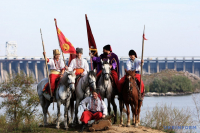How did the Mennonites get to Zaporizhzhia?
The Mennonites are a Protestant denomination that was founded in Zurich in 1525 during the Swiss Reformation.
The role of Mennonites for many years has been deleted from the history of our country under the influence of ideology. Apparently, in an empire called the USSR, it was somehow embarrassing to say that the flagship of Ukrainian engineering, the famous ZAZ, was founded by German Abraham Kopp as a factory of agricultural machinery. And our noble Zaporizhzhia is largely indebted to Herman Nibur, a descendant of the Mennonite Protestants who moved to the land of Verhnia Khortytsia from East
Mennonites got their present name on behalf of the Dutch religious leader Menno Simons. Mennonites began to perceive and call Germans apparently because over the years of their life in Prussia, where they had gone from persecution in their homeland, they switched to a Low German dialect close to the Frisian. First of all, it was about the settlement of the southern lands annexed to the empire in 1775, which were called the Wild Field. To attract Europeans to these territories, Prince Potemkin sent Georg von Trapp, who spoke the Mennonite language, to eastern Prussia. The Mennonites were shown the fertile lands of the Kherson region, promised freedom of religion and freedom of military service, which was extremely important for them, according to religious beliefs.
The communities agreed to move. The first group of immigrants - 228 families - embarked on Easter 1788 and ... ended up on Zaporizhzhia land: while the immigrants were on the road, the tsarist government changed its final destination to the valley near the Dnipro, next to the island of Khortytsia
The first public building of the Mennonite colony was the church, which the settlers erected immediately upon arrival on Zaporizhzhia land, and in 1835 they rebuilt it into a two-story clay one. For many years it was the main church of the Mennonites of the Russian Empire. The Soviet government closed it and in 1935 equipped a cinema in the building. During World War II, church services resumed, but then its building was demolished.
During the relocation of each family, 65 acres of land were allotted - this is 20 times the territory that the Zaporizhzhia Sich complex now occupies on the island of Khortytsia. But only the eldest son inherited the allotment in the usually large families of Mennonites. Other children received money and had to arrange their life themselves. Hence the development of entrepreneurship. From the production of bread wine, to the creation of agricultural machinery, which later grew into mechanical engineering, blacksmithing and metallurgy.
Today in Zaporizhzhia about the people who have created European civilization here for more than 150 years, only buildings resemble those that look very different from the surrounding structures.


